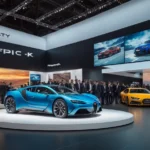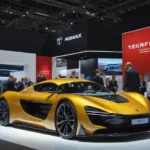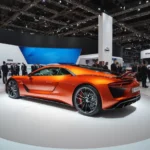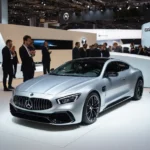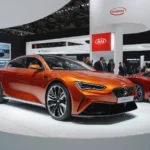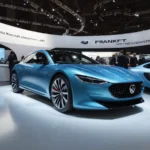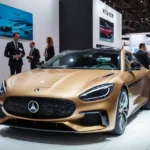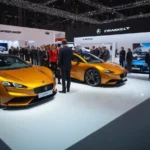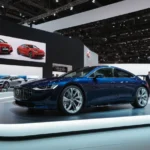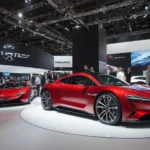Leading projects and new trends at auto shows last year
Introduction to
Booth Media – As a showcase for the latest achievements of the automotive industry, automotive booth projects have always had a special place in introducing new technologies, revolutionary designs and market strategies. In 2022-2023, these exhibitions, with a passionate return to the in-person format, witnessed profound changes in response to global challenges such as climate change, digital transformation and new consumer expectations. This article provides a comprehensive review of the trends, outstanding projects and challenges facing automotive exhibitions in the past year.
Key projects and trends at the 2022-2023 auto shows
1. The undisputed dominance of electric vehicles (EVs)
Electric vehicles have become the undisputed stars of the show circuit. According to the European Automobile Manufacturers’ Association (ACEA) , more than 70% of the products unveiled at shows such as the Paris 2022 and the Los Angeles Auto Show 2022 were all-electric or plug-in hybrids. Companies such as Volkswagen with the introduction of the ID.7 series and General Motors with the Chevrolet Blazer EV have reinforced their strategy to completely eliminate combustion engines by 2035.
2. Autonomous and connected technologies Level 3 autonomous
systems (a car that can take full control under certain conditions) were highlighted in products like the 2023 Mercedes-Benz S-Class and BMW iX . CES 2023 also saw the introduction of software platforms like the Qualcomm Snapdragon Ride , which will allow for the processing of vehicle sensor data at unprecedented speeds.
3. Sustainability beyond the engine: From raw materials to booth design
, the automotive industry has moved towards reducing its carbon footprint at all stages of production and display. For example:
- Toyota unveiled solid-state battery technology at the 2023 Tokyo Motor Show that stores more energy with fewer raw materials.
- Ferrari used recycled carbon fiber and solar panels to provide energy at its stand at Genoa 2023 .
4. Customer-centric experience with virtual reality and personalization Visitors were no longer just spectators; they were exploring the features of cars
through digital avatars in metaverse environments. Audi enabled interior customization of cars in mixed reality (MR) using HoloLens 2 at the 2023 Detroit Auto Show .
Notable exhibitions and outstanding achievements
- Paris Motor Show 2022: The Battleground of Electric Luxury Cars
The competition between the Porsche Mission X (all-electric supercar) and the Mercedes-AMG EQE over offering the highest energy efficiency and 0-100 acceleration under 2 seconds has captured the attention of the media. - CES 2023: The car as a connected smart device
Tech companies like Sony and LG have blurred the line between cars and digital gadgets by introducing cloud-based entertainment systems and AI user interfaces. - Shanghai Expo 2023: Chinese automakers gain strength.
Brands like BYD with the Seal and NIO with the ET5 model expanded their global market share through competitive pricing and replaceable batteries.
Challenges facing the auto show industry
1. Semiconductor shortages and supply chain disruptions
The global chip crisis has prevented some automakers from displaying full physical prototypes at shows. Ford was forced to display only a digital simulation of its F-150 Lightning at the Detroit show .
2. The exorbitant costs of having a physical presence
made it impossible for many startups to hold flashy booths in cities like Geneva or Los Angeles. Solutions such as participating in virtual trade shows or sharing group booths were welcomed.
3. New expectations of Generation Z
Young people are not only looking for advanced technology, but are also sensitive to issues such as supply chain transparency and ethical commitments of brands . A McKinsey survey at the Frankfurt Motor Show showed that 65% of visitors under 30 consider sustainability more important than engine power.
Groundbreaking innovations in booth design and audience interaction
- Tesla
‘s eco-friendly booths at the 2023 Berlin Expo used green roofs and a rainwater collection system to reduce the booth’s energy consumption to zero. - Host and translator robots
At the Tokyo Expo , Toyota used the T-HR3 humanoid robot to guide visitors and provide simultaneous translation into 15 languages. - Interactive virtual reality tests
Visitors to the 2023 New York Expo were able to experience driving Formula E cars in virtual cities using motion simulators .
The future of car shows: evolution or extinction?
Despite the growth of digital technologies, analysts predict that physical exhibitions will not only remain, but will also become multifaceted hubs where:
- Direct sales are made through blockchain-based smart contracts.
- The virtual driving test uses biometric data to provide personalized recommendations.
- Cross-industry collaboration (such as between automakers and energy companies) is on display in vivid form.
Conclusion
Last year’s auto shows proved that the industry is changing: from showcasing engine power to demonstrating ecological commitments , from competing for the most luxurious design to competing for the smartest ecosystem . However, success in this new era requires coordination between three key elements:
1. Integrating digital and physical technologies in booth design .
2. Transparency in the field of production and recycling sources.
3. Investing in training human resources to manage complex exhibition systems.
It seems that future exhibitions will be more of a platform for a global conversation about the future of sustainable mobility than a showcase for products.
- پروژه های پیشرو و ترندهای نوین در نمایشگاه های خودرو در سال گذشته
- پروژه های پیشرو و ترندهای نوین در نمایشگاه های خودرو در سال گذشته
- پروژه های پیشرو و ترندهای نوین در نمایشگاه های خودرو در سال گذشته
- پروژه های پیشرو و ترندهای نوین در نمایشگاه های خودرو در سال گذشته
- پروژه های پیشرو و ترندهای نوین در نمایشگاه های خودرو در سال گذشته
- پروژه های پیشرو و ترندهای نوین در نمایشگاه های خودرو در سال گذشته
- پروژه های پیشرو و ترندهای نوین در نمایشگاه های خودرو در سال گذشته
- پروژه های پیشرو و ترندهای نوین در نمایشگاه های خودرو در سال گذشته Leading projects and new trends at auto shows last year

